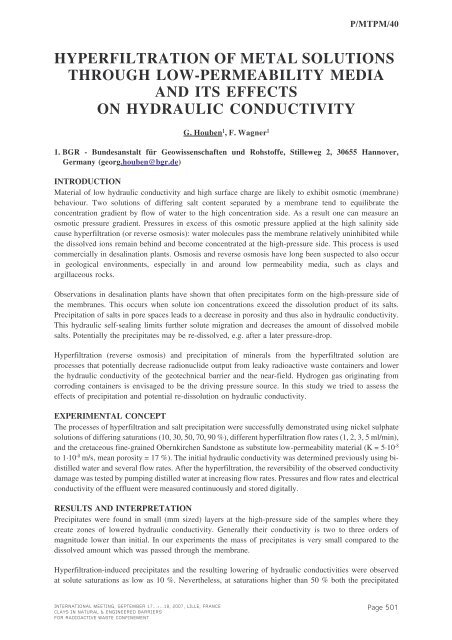Mass Transfer & Porous Media (MTPM) - Andra
Mass Transfer & Porous Media (MTPM) - Andra
Mass Transfer & Porous Media (MTPM) - Andra
Create successful ePaper yourself
Turn your PDF publications into a flip-book with our unique Google optimized e-Paper software.
P/<strong>MTPM</strong>/40HYPERFILTRATION OF METAL SOLUTIONSTHROUGH LOW-PERMEABILITY MEDIAAND ITS EFFECTSON HYDRAULIC CONDUCTIVITYG. Houben 1 , F. Wagner 11. BGR - Bundesanstalt für Geowissenschaften und Rohstoffe, Stilleweg 2, 30655 Hannover,Germany (georg .houben@bgr.de)INTRODUCTIONMaterial of low hydraulic conductivity and high surface charge are likely to exhibit osmotic (membrane)behaviour. Two solutions of differing salt content separated by a membrane tend to equilibrate theconcentration gradient by flow of water to the high concentration side. As a result one can measure anosmotic pressure gradient. Pressures in excess of this osmotic pressure applied at the high salinity sidecause hyperfiltration (or reverse osmosis): water molecules pass the membrane relatively uninhibited whilethe dissolved ions remain behind and become concentrated at the high-pressure side. This process is usedcommercially in desalination plants. Osmosis and reverse osmosis have long been suspected to also occurin geological environments, especially in and around low permeability media, such as clays andargillaceous rocks.Observations in desalination plants have shown that often precipitates form on the high-pressure side ofthe membranes. This occurs when solute ion concentrations exceed the dissolution product of its salts.Precipitation of salts in pore spaces leads to a decrease in porosity and thus also in hydraulic conductivity.This hydraulic self-sealing limits further solute migration and decreases the amount of dissolved mobilesalts. Potentially the precipitates may be re-dissolved, e.g. after a later pressure-drop.Hyperfiltration (reverse osmosis) and precipitation of minerals from the hyperfiltrated solution areprocesses that potentially decrease radionuclide output from leaky radioactive waste containers and lowerthe hydraulic conductivity of the geotechnical barrier and the near-field. Hydrogen gas originating fromcorroding containers is envisaged to be the driving pressure source. In this study we tried to assess theeffects of precipitation and potential re-dissolution on hydraulic conductivity.EXPERIMENTAL CONCEPTThe processes of hyperfiltration and salt precipitation were successfully demonstrated using nickel sulphatesolutions of differing saturations (10, 30, 50, 70, 90 %), different hyperfiltration flow rates (1, 2, 3, 5 ml/min),and the cretaceous fine-grained Obernkirchen Sandstone as substitute low-permeability material (K = 5·10 -8to 1·10 -9 m/s, mean porosity = 17 %). The initial hydraulic conductivity was determined previously using bidistilledwater and several flow rates. After the hyperfiltration, the reversibility of the observed conductivitydamage was tested by pumping distilled water at increasing flow rates. Pressures and flow rates and electricalconductivity of the effluent were measured continuously and stored digitally.RESULTS AND INTERPRETATIONPrecipitates were found in small (mm sized) layers at the high-pressure side of the samples where theycreate zones of lowered hydraulic conductivity. Generally their conductivity is two to three orders ofmagnitude lower than initial. In our experiments the mass of precipitates is very small compared to thedissolved amount which was passed through the membrane.Hyperfiltration-induced precipitates and the resulting lowering of hydraulic conductivities were observedat solute saturations as low as 10 %. Nevertheless, at saturations higher than 50 % both the precipitatedINTERNATIONAL MEETING, SEPTEMBER 17...>...18, 2007, LILLE, FRANCECLAYS IN NATURAL & ENGINEERED BARRIERSFOR RADIOACTIVE WASTE CONFINEMENTPage 501
















